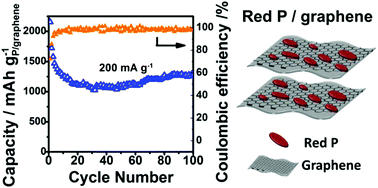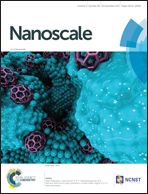Amorphous red phosphorus nanosheets anchored on graphene layers as high performance anodes for lithium ion batteries†
Abstract
A facile solution-based method was developed to combine the advantage of amorphous nanoscale red P sheets and highly conductive graphene, forming a high-performance P/graphene composite anode for advanced lithium ion batteries. Graphene can be easily expanded into a 3D framework in solution with rich interior porosity and abundant adsorption points, which enables a large percentage of red P to be loaded and form a uniform P/graphene hybrid structure. The nanoscale and amorphous features of red P effectively reduce the volume expansion and mechanical stress within individual P sheets, thereby alleviating P pulverization during cycling. The well dispersed graphene serves as a buffer layer to accommodate the volume expansion and adsorb the stress during electrochemical reactions, thereby maintaining a robust electrode structure. Besides, the highly conductive graphene greatly enhances the ionic/electronic conductivity of the electrode, which favors efficient redox reactions and high P utilization. Based on the superior composite structure, the potentials of both components can be fully exerted, resulting in excellent electrochemical performance. The P/graphene electrode delivered a high reversible capacity of 1286 mA h g−1 based on the weight of the composite after 100 cycles at 200 mA g−1. Even at a high current density of 1000 mA g−1, the composite electrode exhibits a high capacity of 1125 mA h g−1, revealing its potential as a high-performance P-carbon composite anode for advanced lithium ion batteries.



 Please wait while we load your content...
Please wait while we load your content...